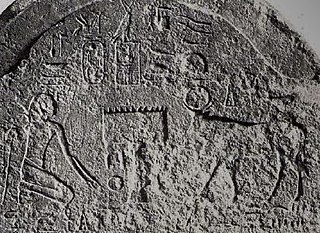This article needs additional citations for verification .(February 2024) |
This article concerns the period 529 BC – 520 BC.
Contents
| Millennium |
|---|
| 1st millennium BC |
| Centuries |
| Decades |
| Years |
| Categories |
This article needs additional citations for verification .(February 2024) |
This article concerns the period 529 BC – 520 BC.
| Millennium |
|---|
| 1st millennium BC |
| Centuries |
| Decades |
| Years |
| Categories |

The 5th century BC started the first day of 500 BC and ended the last day of 401 BC.
The 6th century BC started on the first day of 600 BC and ended on the last day of 501 BC.

Cambyses II was the second King of Kings of the Achaemenid Empire from 530 to 522 BC. He was the son and successor of Cyrus the Great and his mother was Cassandane.

Darius I, commonly known as Darius the Great, was a Persian ruler who served as the third King of Kings of the Achaemenid Empire, reigning from 522 BCE until his death in 486 BCE. He ruled the empire at its territorial peak, when it included much of Western Asia, parts of the Balkans and the Caucasus, most of the Black Sea's coastal regions, Central Asia, the Indus Valley in the far east, and portions of North Africa and Northeast Africa including Egypt (Mudrâya), eastern Libya, and coastal Sudan.

This article concerns the period 409 BC – 400 BC.

This is a timeline of ancient Greece from its emergence around 800 BC to its subjection to the Roman Empire in 146 BC.
The year 522 BC was a year of the pre-Julian Roman calendar. In the Roman Empire, it was known as year 232 Ab urbe condita. The denomination 522 BC for this year has been used since the early medieval period, when the Anno Domini calendar era became the prevalent method in Europe for naming years.

Bardiya or Smerdis, also named as Tanyoxarces by Ctesias, was a son of Cyrus the Great and the younger brother of Cambyses II, both Persian kings. There are sharply divided views on his life. Bardiya either ruled the Achaemenid Empire for a few months in 522 BCE, or was impersonated by a magus called Gaumata, whose name is given by Ctesias as Sphendadates, until he was toppled by Darius the Great.

Hippias was the last tyrant of Athens, ruling from 527 to 510 BC. He was one of the Peisistratids, a group of three tyrants in Ancient Greece. Pisistratus first, and then his son, Hippias, followed after him by Hippias' illegitimate son, Hegesistratos. He was deposed when Cleomenes I of Sparta successfully invaded Athens and forced him to flee to Persia.
Psamtik III, known by the Graeco-Romans as Psammetichus or Psammeticus, or Psammenitus, was the last Pharaoh of the Twenty-sixth Dynasty of Egypt from 526 BC to 525 BC. Most of what is known about his reign and life was documented by the Greek historian Herodotus in the 5th century BC. Herodotus states that Psamtik had ruled Egypt for only six months before he was confronted by a Persian invasion of his country led by King Cambyses II of Persia. Psamtik was subsequently defeated at the Battle of Pelusium, and fled to Memphis where he was captured. The deposed pharaoh was carried off to Susa in chains, and later committed suicide.

The Late Period of ancient Egypt refers to the last flowering of native Egyptian rulers after the Third Intermediate Period in the 26th Saite Dynasty founded by Psamtik I, but includes the time of Achaemenid Persian rule over Egypt after the conquest by Cambyses II in 525 BC as well. The Late Period existed from 664 BC until 332 BC, following a period of foreign rule by the Nubian 25th Dynasty and beginning with a short period of Neo-Assyrian suzerainty, with Psamtik I initially ruling as their vassal. The period ended with the conquests of the Persian Empire by Alexander the Great and establishment of the Ptolemaic dynasty by his general Ptolemy I Soter, one of the Hellenistic diadochi from Macedon in northern Greece. With the Macedonian Greek conquest in the latter half of the 4th century BC, the age of Hellenistic Egypt began.
The history of Persian Egypt is divided into two eras following the first Achaemenid conquest of Egypt punctuated by an interval of independence:

Seheruibre Padibastet better known by his Hellenised name Petubastis III was a native ancient Egyptian ruler, who revolted against Persian rule.

The Twenty-seventh Dynasty of Egypt, also known as the First Egyptian Satrapy, was a satrapy of the Achaemenid Empire between 525 and 404 BC. It was founded by Cambyses II, the King of Persia, after the Battle of Pelusium and the Achaemenid conquest of Egypt, and his subsequent crowning as Pharaoh of Egypt. It was disestablished upon the rebellion and crowning of Amyrtaeus as Pharaoh. A second period of Achaemenid rule in Egypt occurred under the Thirty-first Dynasty of Egypt.
Phaedymia was the daughter of Otanes, a Persian noble a highly influential noble at the Achaemenid court. She was married in turn to Cambyses II, Bardiya (Gaumata?) and Darius I.
The Teispids were an Iron Age branch of the Achaemenid dynasty originally ruling the southern Zagros, in ancient Anshan. The dynasty’s realm was later expanded under Cyrus II, who conquered a vast area in southwestern Asia, founding what was later known as the Achaemenid Empire under Darius I. The titulary of the Teispids is recorded on the Cyrus Cylinder, in which Cyrus II identifies himself and his ancestors with the title King of Anshan, as an Elamite tradition. Teispes being the eponymous ancestor and founder, the dynasty furthermore included Cyrus I, Cambyses I, Cyrus II, Cambyses II and Bardiya.

The Achaemenid Empire or Achaemenian Empire, also known as the Persian Empire or First Persian Empire, was an ancient Iranian empire founded by Cyrus the Great of the Achaemenid dynasty in 550 BC. Based in modern-day Iran, it was the largest empire by that point in history, spanning a total of 5.5 million square kilometres. The empire spanned from the Balkans and Egypt in the west, West Asia as the base, the majority of Central Asia to the northeast, and the Indus Valley to the southeast.

Oroetus, or Oroetes, was a Persian Satrap of Lydia, during the reigns of Cyrus the Great, Cambyses and Darius the Great, succeeding Harpagus, and being followed by Bagaeus. He is described by Herodotus in the third book of his Histories, where he achieved notoriety for the death of Polycrates, tyrant of Samos:
What I will now relate happened about the time of Cambyses' sickness. The viceroy of Sardis appointed by Cyrus was Oroetes, a Persian. This man purposed to do a great wrong; for though he had received no hurt by word or deed from Polycrates of Samos, nor had even seen him, he formed the desire of seizing and killing him. The reason alleged by most was this: — As Oroetes and another Persian, Mitrobates by name, governor of the province of Dascyleium, sat by the king's door, they fell from talk to wrangling and comparing of their several achievements: and Mitrobates taunted Oroetes, saying, "You are not to be accounted a man; the island of Samos lies close to your province, yet you have not added it to the king's dominion — an island so easy to conquer that some native of it rose against his rulers with fifteen men at arms, and is now lord of it. Some say that Oroetes, angered by this taunt, was less desirous of punishing the utterer of it than of by all means destroying the reason of the reproach, namely Polycrates.

The first Achaemenid conquest of Egypt took place in 525 BCE, leading to the foundation of the Twenty-seventh Dynasty of Egypt, also known as the "First Egyptian Satrapy". Egypt thus became a satrapy of the Achaemenid Empire until 404 while still maintaining Egyptian royalty customs and positions. The conquest was led by Cambyses II, who defeated the Egyptians at the Battle of Pelusium, and crowned himself pharaoh. Achaemenid rule was disestablished upon the rebellion and crowning of Amyrtaeus as Pharaoh. A second period of Achaemenid rule in Egypt occurred under the Thirty-first Dynasty of Egypt.